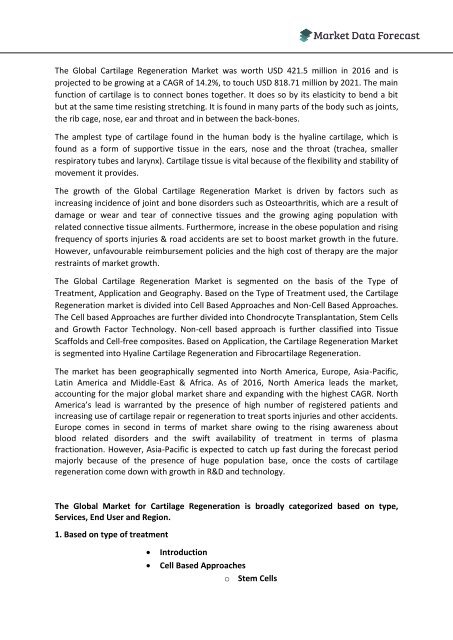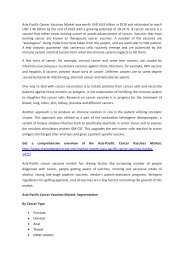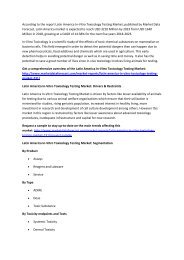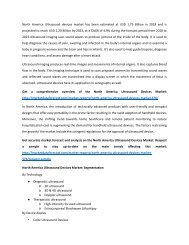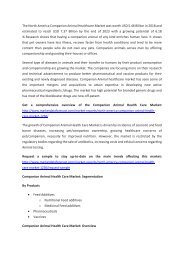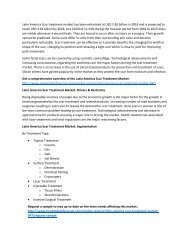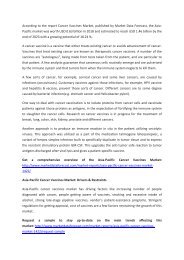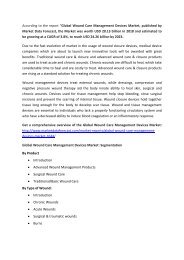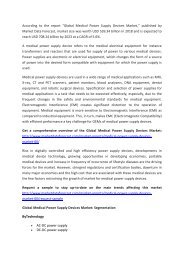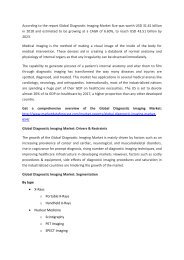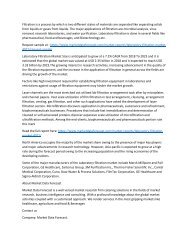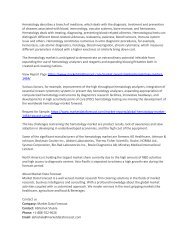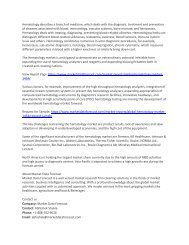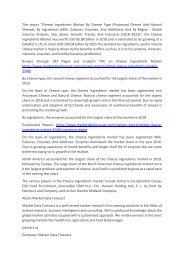Cartilage Regeneration Market
Create successful ePaper yourself
Turn your PDF publications into a flip-book with our unique Google optimized e-Paper software.
The Global <strong>Cartilage</strong> <strong>Regeneration</strong> <strong>Market</strong> was worth USD 421.5 million in 2016 and is<br />
projected to be growing at a CAGR of 14.2%, to touch USD 818.71 million by 2021. The main<br />
function of cartilage is to connect bones together. It does so by its elasticity to bend a bit<br />
but at the same time resisting stretching. It is found in many parts of the body such as joints,<br />
the rib cage, nose, ear and throat and in between the back-bones.<br />
The amplest type of cartilage found in the human body is the hyaline cartilage, which is<br />
found as a form of supportive tissue in the ears, nose and the throat (trachea, smaller<br />
respiratory tubes and larynx). <strong>Cartilage</strong> tissue is vital because of the flexibility and stability of<br />
movement it provides.<br />
The growth of the Global <strong>Cartilage</strong> <strong>Regeneration</strong> <strong>Market</strong> is driven by factors such as<br />
increasing incidence of joint and bone disorders such as Osteoarthritis, which are a result of<br />
damage or wear and tear of connective tissues and the growing aging population with<br />
related connective tissue ailments. Furthermore, increase in the obese population and rising<br />
frequency of sports injuries & road accidents are set to boost market growth in the future.<br />
However, unfavourable reimbursement policies and the high cost of therapy are the major<br />
restraints of market growth.<br />
The Global <strong>Cartilage</strong> <strong>Regeneration</strong> <strong>Market</strong> is segmented on the basis of the Type of<br />
Treatment, Application and Geography. Based on the Type of Treatment used, the <strong>Cartilage</strong><br />
<strong>Regeneration</strong> market is divided into Cell Based Approaches and Non-Cell Based Approaches.<br />
The Cell based Approaches are further divided into Chondrocyte Transplantation, Stem Cells<br />
and Growth Factor Technology. Non-cell based approach is further classified into Tissue<br />
Scaffolds and Cell-free composites. Based on Application, the <strong>Cartilage</strong> <strong>Regeneration</strong> <strong>Market</strong><br />
is segmented into Hyaline <strong>Cartilage</strong> <strong>Regeneration</strong> and Fibrocartilage <strong>Regeneration</strong>.<br />
The market has been geographically segmented into North America, Europe, Asia-Pacific,<br />
Latin America and Middle-East & Africa. As of 2016, North America leads the market,<br />
accounting for the major global market share and expanding with the highest CAGR. North<br />
America’s lead is warranted by the presence of high number of registered patients and<br />
increasing use of cartilage repair or regeneration to treat sports injuries and other accidents.<br />
Europe comes in second in terms of market share owing to the rising awareness about<br />
blood related disorders and the swift availability of treatment in terms of plasma<br />
fractionation. However, Asia-Pacific is expected to catch up fast during the forecast period<br />
majorly because of the presence of huge population base, once the costs of cartilage<br />
regeneration come down with growth in R&D and technology.<br />
The Global <strong>Market</strong> for <strong>Cartilage</strong> <strong>Regeneration</strong> is broadly categorized based on type,<br />
Services, End User and Region.<br />
1. Based on type of treatment<br />
<br />
<br />
Introduction<br />
Cell Based Approaches<br />
o Stem Cells


